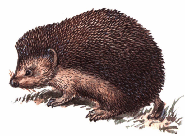 Not much is known about the Daurian hedgehog (Mesechinus dauuricus) or (Erinaceus dauuricus), but scientists know more about this solitary and elusive little mammal since the 1960s, when use of broad-spectrum insecticides and rodenticides almost wiped out the species. Daurian hedgehogs primarily eat insects and mice. Coming across a load of dead prey is too tempting for any hedgehog to pass up. Unfortunately, the poison that killed the insects can also kill hedgehogs.
Not much is known about the Daurian hedgehog (Mesechinus dauuricus) or (Erinaceus dauuricus), but scientists know more about this solitary and elusive little mammal since the 1960s, when use of broad-spectrum insecticides and rodenticides almost wiped out the species. Daurian hedgehogs primarily eat insects and mice. Coming across a load of dead prey is too tempting for any hedgehog to pass up. Unfortunately, the poison that killed the insects can also kill hedgehogs.The Daurian hedgehog has adapted to a wide territory of northern China, Russia (especially in the Dauria region) and Mongolia. It prefers to live alone near water sources in steppes, grasslands, farmed fields and forests. Although this species is so rare in Russia that it is protected by law, the International Union for the Conservation of Nature lists the species as thriving based on its population worldwide. But the ICUN notes that if the natural habitat was destroyed, the species population would plummet.
Physical Description
The adult Daurian hedgehog is primarily shades of brown, with their backs and tops of the heads covered in soft, spine-like material. The spines are grooved to help burrow underground and possibly to discourage predator bites. A white variation exists, with white bodies but grey spines. Unlike an albino, these hedgehogs have dark eyes and noses.
Another less common name for the Daurian hedgehog is the long-eared hedgehog. Unfortunately, there is another species of hedgehog that spreads from China to Africa called the long-eared hedgehog (Hemiechinus auritus) which can confuse laypeople and biologists. But both species do sport prominent tan triangular ears that are much larger than the European hedgehog. These ears help the hedgehogs detect movements of their prey, which not only includes insects but small rodents, small reptiles, baby bird and eggs. They also eat carrion, including dead insects.
Life Cycle and Behavior
Adult Daurian hedgehogs break their solitary lives to search for mates in June and July. It is unknown exactly how long a female Daurian hedgehog’s gestation is. She gives birth to a litter of 3 to 7. Two months later, they are weaned and finding food for themselves. During this brief childhood, the mother hedgehog teaches her babies how to hide from their main predators of badgers, foxes, wolves, eagle owls and eagles. If the babies can’t get underground, they are to roll up in a tight ball so that the predators can only bite spines.
In order to survive the brutal Russian, Chinese or Mongolian winters, hedgehogs hibernate and do not wake up until April. They can have several small burrows in a territory so that they can always be near a hiding spot should a predator appear. Each hedgehog, male and female, keeps a territory of 12.4 to 24.7 acres (5 to 10 hectares.) Although equipped with tough claws, Daurian hedgehogs prefer to use burrows made and abandoned by other creatures rather than dig their own. They prefer old ground squirrel and marmot burrows. With luck, a Daurian hedgehog can live to the ripe old age of six.
The Daurian hedgehog is listed as Least Concern (LR/lc), lowest risk. Does not qualify for a more at risk category. Widespread and abundant taxa are included in this category, on the IUCN Red List of Threatened Species
Namings for the Daurian hedgehog
A young / baby of a Daurian hedgehog is called a 'hoglet'. The females are called 'sow' and males 'boar'. A Daurian hedgehog group is called a 'array'.
Custom Search